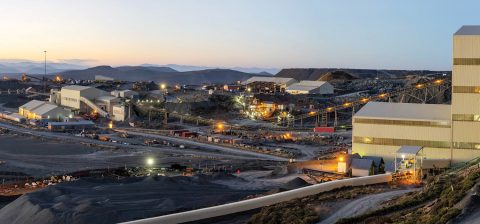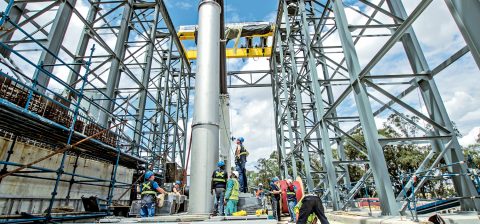SA Mining
Coal Expert Talks Coal For The Future
First are the large mines (cost-plus), second are the medium-sized mines and last the small mines. The first and second group, he explains, delivered 84% of the coal burned by Eskom last year.
“Most of the mines in the first group, i.e. the big producers, will soon have to re-negotiate their contracts. Many will need additional investment to increase or maintain their production levels.
“If that finance is not available, many mines will cut production or cease operations by about 2020. Then the famous “coal cliff” will then become a reality,” he believes.
The question arises, why are coal companies not investing? Prévost explains that this could be the result of the economic climate; the belief by some that coal mining is no longer a good investment; the current policy of Eskom to buy only on contractual basis (not to co-invest in mines); and the 51% black economic empowerment (BEE) procurement prerequisite required by Eskom.
Further, he adds that most of the lower-quality coals are sold locally at better prices than exports. “The better-quality, i.e. 6000kcal/kg coals also have users in the inland market, if they are screened and sized. One thing is certain, with the ongoing energy crisis in South Africa, coal prices in the inland market cannot decrease – they will increase,” says Prévost.
In addition, the belief that coal from the Waterberg region could replace the dwindling output from the Witbank coalfield is a ‘pipe dream’, he says. This, he explains, is due to the complexity of the Waterberg coal geology and the high transport costs involved. “The Waterberg coal cannot be used by power stations in Mpumalanga.”
“Will all these changes produce an industry comparable to that or previous years, when coal was ‘King’? Probably not, but at least it will prevent more mine closures and the growing unemployment in South Africa.”
Stronger, small coal sector
What can be expected from the coal industry in 2017?
“Probably a smaller, stronger industry that is capable of accepting the challenges imposed by smaller profit margins, lower seaborne prices and legislation that will negatively impact on current and future coal mines,” Prévost argues.
“The worse enemies of the industry would be the outcomes emanating from the United Nations Conference of Parties 21, held in Paris last year; and the oversupply created by exporters eager to grow, like Colombia and Australia, in a market that requires the opposite ― less production to be able to balance demand and supply.”
Prévost explains that Colombia has become a formidable competitor, as it threatens to seize a large portion of India’s imports, South Africa’s main customer in Asia. “The coal in Colombia is competitively priced into that market, while South African is hampered by inexplicable and much higher prices.”
While some of the Far East, Middle East and African countries are still striving to increase their steam coal usage, “South Africa is developing a market in Africa ― once very small, but now growing yearly. We might increase exports to these areas in the future.”
He adds that the failure by Indonesian thermal coal producers to indicate any significant cut in production for 2016; made it unlikely for prices to recover in the near term as demand in the main coal consuming countries continue to be low. “The thermal coal market remains victim of weaker demand from key importers. The continued support of China’s domestic industry and rising Indian supply diminishes any chance of a prolonged price recovery.”
For South Africa, Prévost says since the country’s exports need to decrease, given that markets are oversupplied and there is less exportable coal at the current prices, the country does not really need more port and export rail capacity. “Most of our exports ― 57% – in 2016 went to India, but for how long?”
“If investments are available, it would best to use them for rail, to move coal from mines to local users (Eskom and others) and to build inland coal hubs. These might [enormously] facilitate logistics and decrease expenses for mines and users in South Africa.
“The development of a strong local market is needed if the industry wants to survive. Exporting is not producing enough revenue to justify expenditure. Inland coal resources have to be increased, in grades and volumes. With the advent of the independent power producers, there will be an increased need of thermal coal, even if Eskom decreases its burn.”
However, he believes there are big changes ahead for the coal sector globally. “The once powerful, ever-present coal majors, with some small exceptions, have almost entirely disappeared from view, and juniors have dwindled to very small numbers.”
As competition intensifies, Prévost believes that various constraints will hinder coal prices and coal power expansions. “It is widely agreed that coal is likely to stay in the energy mix for a long time to come. There is no alternative energy that could provide reasonably priced electricity and no solid replacement for steel-making. The future for coal seems to lie mainly in Asia. It is expected that Pacific demand will continue increasing and that the Atlantic’s needs would continue to decline as result of weak demand – not a shortage in supply. The conditions that determine coal’s market position continue to become consistently tougher. But coal’s light is still burning bright.”
Meanwhile, with regard to the future of coal in South Africa, Prévost describes it as “not too brilliant”.
“If some or all of the projected pieces of legislation government is planning to implement are acted, probably the local industry will not be able to survive. If not, we still have a chance to continue to produce and use coal for the benefit of the total industry and the domestic consumers of electricity. Without coal, electricity prices could escalate to heights beyond the reach of the average South African people.
“We have enough coal resources deemed to last for more than 100 years, but without the proper finances to implement new mines to replace the old closing ones, the resources will never be extracted, and their value for the country would be nothing,” Prévost concludes.







 Sign-up and receive the Business Media MAGS newsletter OR SA Mining newsletter straight to your inbox.
Sign-up and receive the Business Media MAGS newsletter OR SA Mining newsletter straight to your inbox.